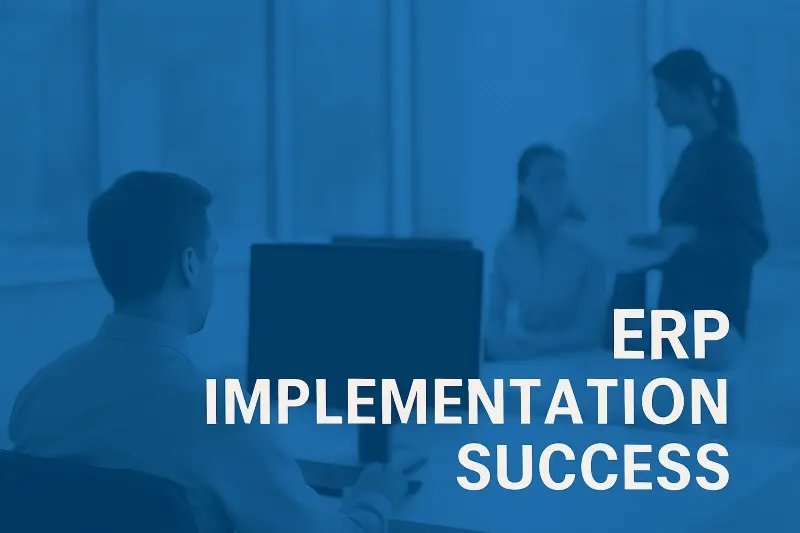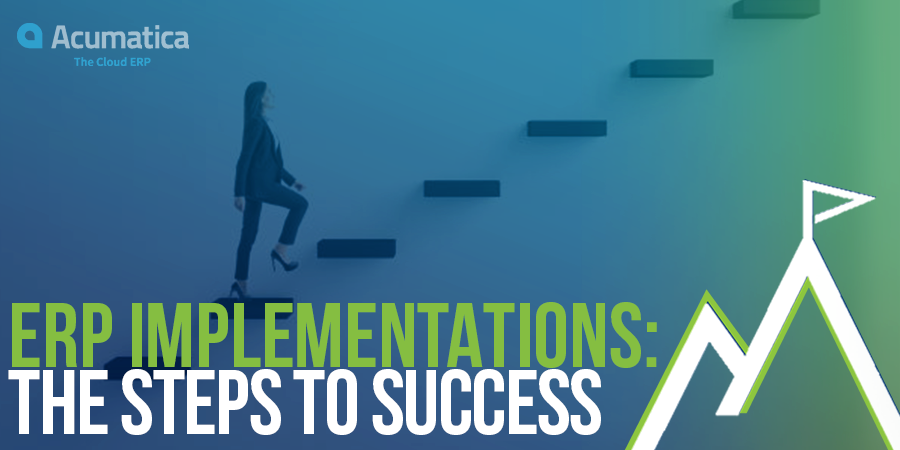The ERP Implementation Process: Steps to Success
Once the decision has been made to implement a new ERP or financial software system, the real work begins. This phase is critical—it demands careful...

Table of Contents
Updated 9/9/25
Rolling out a new ERP system can feel like a leap into the unknown. But with the right approach, ERP implementation success is absolutely achievable for any business. This journey isn’t just about acquiring the latest technology—it’s about putting your people and your priorities front and center, making choices that drive lasting performance.
Showy ERP demos can dazzle anyone. Cool dashboards, AI features, and niche modules often steal your attention. But real ERP implementation success means knowing which features truly matter.
Think about it like car shopping. Sure, cooling seats or a heated steering wheel might sound amazing—and they’re great talking points on the dealer’s lot—but if you’re just hopping around town, what you really want is reliability, comfort, and performance. In ERP, it’s easy to get drawn toward the “extras,” but you'll reap the most value by focusing on the priorities that support your business now and set you up for growth.
Modern businesses are changing and moving faster than ever. Remote work, digital tools, and instant decisions are the new normal. For ERP implementation success, you need to address:
Cloud-First Platforms: Today’s ERPs live in the cloud, offering access from anywhere and less IT hassle.
Integration & Automation: The right ERP pulls all your business tools together—CRM, eCommerce, HR—and ensures automated, efficient workflows.
Data Security & Compliance: Robust protections and regulatory readiness let you operate with confidence.
Anytime, Anywhere Access: Everyone from accounting to operations can make decisions and get work done—no matter where they are.

Start your ERP implementation success journey with honesty.
What’s working well in your current operations?
Where do your teams run into trouble or bottlenecks?
Gather feedback from every department—from formal surveys to casual conversations.
Most importantly, look ahead.
Are you planning expansion, new products, or acquisitions?
Is your team growing?
Your ERP should be a launchpad for your next big steps—not just a fix for today.
Your users are the real experts in how work gets done.
Invite open conversations: surveys, workshops, team meetings—it all counts.
Ask what would actually make their work better or easier.
When people see their input guiding decisions, adoption skyrockets.
Get everyone involved—finance, warehouse, sales, customer service, production.
The more voices you hear, the more your ERP will solve real, everyday challenges.
Don’t let your ERP wish list spiral out of control. Sort features into four buckets:
Absolute Requirements: You can’t launch without these.
Highly Desirable: They smooth processes but aren’t showstoppers.
Future Needs: Plan for tomorrow’s growth—your ERP should scale with you.
Nice to Haves: The “cooling seats and heated steering wheel” features—add when ready, not right away.
This framework keeps ERP implementation success on track and focused on tangible results.

Ask the right questions:
Will this feature deliver noticeable business value or make work easier?
Who in your organization will actually use and benefit from it?
What does it take—in time, money, and disruption—to put it in place?
Does this feature still matter as you grow?
A focused approach prevents over-complication and controls costs.
Resist the urge to roll everything out at once. Instead, tackle ERP implementation in manageable phases that set your team up for success.
Start with core features: Focus first on the essentials—modules that solve your biggest pain points and keep daily operations running smoothly.
Enhance as you go: Once your team is comfortable, introduce additional features and useful integrations. Gradual enhancements help drive stronger user adoption.
Stay flexible: Regularly reassess your priorities and adapt your ERP plan as your business evolves. Phased implementation gives you space to learn, adjust, and respond to changing needs.
Rolling out your ERP in phases keeps momentum high, reduces risk and overwhelm, and allows your team to experience ERP implementation success sooner—and more confidently.
The secret to ERP implementation success? It’s not just the technology—it’s your team. Even the best system will fall flat if users aren’t engaged and empowered to use it. The way you manage change during an ERP rollout can make or break your project.
Invest in hands-on training:
Make sure every user gets practical, role-based training—not just a manual or a single workshop. Allow them to practice with real data and workflows so they feel confident before go-live.
Explain the “why” behind changes:
Share the business goals driving the ERP project. Connect changes to everyday improvements: faster reporting, easier collaboration, fewer manual tasks. Clear communication helps people understand the purpose instead of seeing ERP as just another directive.
Choose department champions:
Identify respected employees from each team to serve as ERP ambassadors. These champions answer questions, provide informal support, and encourage their peers—bridging the gap between project leaders and end users.
Create feedback loops:
Invite honest feedback through regular check-ins, open forums, or anonymous surveys. Respond quickly to concerns and adapt training or processes as needed. Making people feel heard reduces uncertainty and resistance.
Celebrate early wins:
Highlight quick successes, like a smoother process or time saved, and publicly recognize teams or individuals who embrace the new system. Positivity builds momentum and enthusiasm across the organization.
When your people feel valued, informed, and included at every stage, they’ll turn the ERP system into an engine for true business transformation. Change management isn’t an afterthought—it’s at the heart of ERP implementation success.
ERP implementations rarely fail because of the software itself. They stall, derail, or under-deliver because of avoidable mistakes in planning and execution. Here are the key pitfalls businesses encounter—and how you can steer clear of them:
Feature Creep
It’s tempting to say yes to every shiny new feature, but each “extra” adds time, complexity, and cost. What started as a well-scoped project can quickly spiral out of control.
How to avoid it: Revisit your requirement buckets (must-have, highly desirable, future, nice-to-have) regularly. Stick to the essentials for go-live; save the extras for later, once your system is stable.
Integration Overload
Connecting your ERP to every other platform from day one can overwhelm your system and your team. Too many integrations too soon can cause data mismatches, testing headaches, and unnecessary delays.
How to avoid it: Roll out integrations in stages. Start with the most critical—finance, CRM, inventory—test thoroughly, then expand.
Weak Vendor or Partner Support
Some vendors are enthusiastic during sales but disappear when it’s time to implement and support. Without reliable help, troubleshooting drags and momentum fades.
How to avoid it: Choose a solution and implementation partner with a proven record for ongoing service, not just software delivery. Ask about post-launch support, training, and customer success stories.
Ignoring Change Management
ERP success isn’t just technical—it’s about people and culture. If you don’t prepare your teams for new processes, you’ll face resistance, workarounds, and poor adoption.
How to avoid it: Build a clear change management plan that includes open communication, thorough training, department champions, and feedback opportunities. If your people aren’t on board, your system won’t succeed.
Unrealistic Timelines
Trying to go live too fast can mean skipped testing and superficial training—setting the stage for bigger problems later.
How to avoid it: Create a phased roadmap with achievable milestones. Give your team time to learn, adapt, and test before pushing forward.
Lack of Executive Sponsorship
Without visible support from leadership, ERP projects lose momentum and buy-in. The system is seen as “an IT project” instead of a companywide transformation.
How to avoid it: Secure executive sponsorship from the outset. Leaders should communicate the “why,” reinforce goals, and celebrate wins along the way.
Use project checklists and prioritization templates: Keep your team organized, track steps, and make sure everyone understands what’s important and what comes next. Structured tools help streamline planning and ensure nothing gets overlooked.
Get outside input: Lessons from experienced consultants or peer companies can help you spot issues early and make smarter decisions. A fresh perspective often sheds light on blind spots and provides actionable tips you might not find internally.
Recognize progress along the way: Celebrate milestones and successful launches, even small wins. Acknowledgment keeps morale high, boosts engagement, and ensures your team stays motivated throughout the ERP journey.
ERP implementation success isn’t about chasing every new feature—it’s about finding what fits, planning for growth, and empowering your people to thrive.
At Milestone, we help you sort needs from wants, create a tailored roadmap, and guide your team to lasting ERP success. Let’s build a solution suited to your business, your teams, and your future.
Contact Milestone today to get started on your ERP implementation journey.

Once the decision has been made to implement a new ERP or financial software system, the real work begins. This phase is critical—it demands careful...